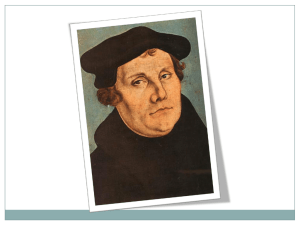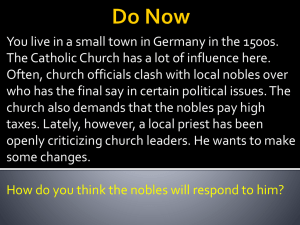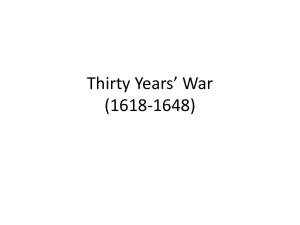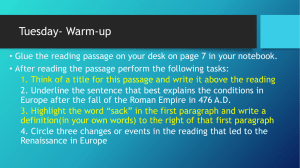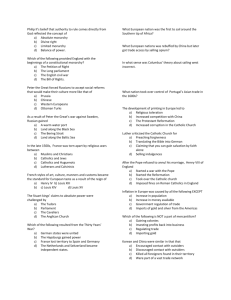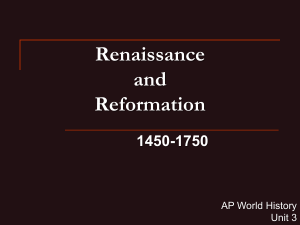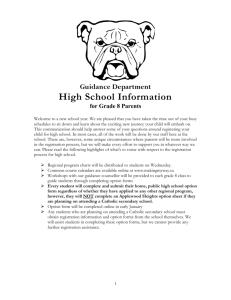Document-Based Questions: Time Period 1 (ANSWER KEY)
advertisement
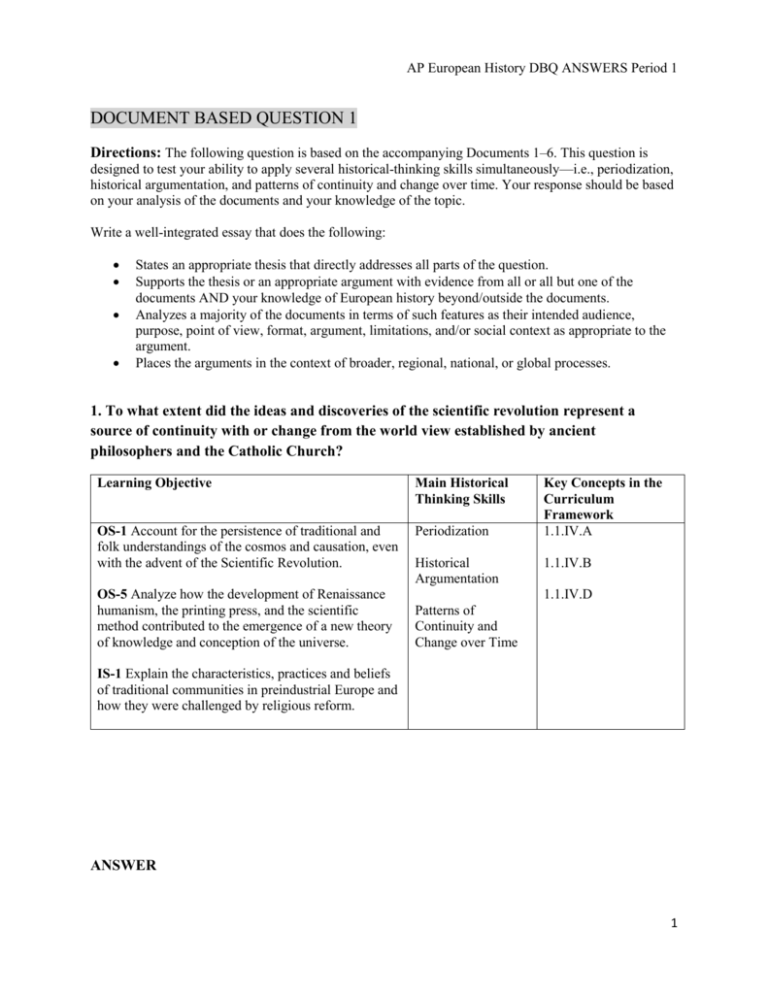
AP European History DBQ ANSWERS Period 1 DOCUMENT BASED QUESTION 1 Directions: The following question is based on the accompanying Documents 1–6. This question is designed to test your ability to apply several historical-thinking skills simultaneously—i.e., periodization, historical argumentation, and patterns of continuity and change over time. Your response should be based on your analysis of the documents and your knowledge of the topic. Write a well-integrated essay that does the following: States an appropriate thesis that directly addresses all parts of the question. Supports the thesis or an appropriate argument with evidence from all or all but one of the documents AND your knowledge of European history beyond/outside the documents. Analyzes a majority of the documents in terms of such features as their intended audience, purpose, point of view, format, argument, limitations, and/or social context as appropriate to the argument. Places the arguments in the context of broader, regional, national, or global processes. 1. To what extent did the ideas and discoveries of the scientific revolution represent a source of continuity with or change from the world view established by ancient philosophers and the Catholic Church? Learning Objective Main Historical Thinking Skills OS-1 Account for the persistence of traditional and folk understandings of the cosmos and causation, even with the advent of the Scientific Revolution. Periodization OS-5 Analyze how the development of Renaissance humanism, the printing press, and the scientific method contributed to the emergence of a new theory of knowledge and conception of the universe. Historical Argumentation Key Concepts in the Curriculum Framework 1.1.IV.A 1.1.IV.B 1.1.IV.D Patterns of Continuity and Change over Time IS-1 Explain the characteristics, practices and beliefs of traditional communities in preindustrial Europe and how they were challenged by religious reform. ANSWER 1 AP European History DBQ ANSWERS Period 1 Thesis Possible thesis statements could include the following: The Scientific Revolution was a complete split from the views of ancient philosophers and the Catholic Church. The Scientific Revolution was a repudiation of much of the world view of the Catholic Church but maintained continuity with the ideals of ancient philosophers. The Scientific Revolution was a source of continuity in the development of knowledge from ancient philosophers and the doctrines of the Catholic Church. Analysis of Documents To earn full credit for analysis of documents, responses must offer at least one of the following for all or all but one of the documents: intended audience, purpose, historical context, author’s point of view. The analyses must also support the stated thesis or a relevant argument. 2 AP European History DBQ ANSWERS Period 1 Document 1 Source: Nicolaus Copernicus, “To His Holiness, Pope Paul III,” Preface to On the Revolutions of the Heavenly Spheres, 1543 Those who know that the consensus of many centuries has sanctioned the conception that the earth remains at rest in the middle of the heaven as its center would, I reflected, regard it as an insane pronouncement if I made the opposite assertion that the earth moves. . . . . However, Your Holiness will perhaps not be greatly surprised that I have dared to publish my studies after devoting so much effort to working them out that I did not hesitate to put down my thoughts about the earth’s motion in written form too. But you are rather waiting to hear from me how it occurred to me to venture to conceive any motion of earth, against the traditional opinion of astronomers and almost against common sense. I have accordingly no desire to [hide] from Your Holiness that I was impelled to consider a different system of deducing the motions of the universe’s spheres for no other reason than the realization that astronomers do not agree among themselves in their investigations of this subject. For, in the first place, they are so uncertain about the motion of the sun and moon that they cannot establish and observe a constant length even for the tropical year. Secondly, in determining the motions not only of these bodies but also of the other five planets, they do not use the same principles, assumptions, and explanations of the apparent revolutions and motions. . . . . For a long time, then, I reflect on this confusion in the astronomical traditions concerning the derivation of the motions of the universe’s spheres. I began to be annoyed that the movements of the world machine. Created for our sake by the best and most systematic Artisan of all, were not understood with greater certainty by the philosophers, who otherwise examined so precisely the most insignificant trifles of this world. For this reason I undertook the task of rereading the works of all the philosophers which I could obtain to learn whether anyone had ever proposed other motions of the universe's spheres than those expounded by the teachers of astronomy in the schools. And in fact first I found in Cicero that Hicetas supposed the earth to move. Later I also discovered in Plutarch that certain others were of this opinion. I have decided to set his words down here, so that they may be available to everybody: Some think that the earth remains at rest. But Philolaus the Pythagorean believes that, like the sun and moon, it revolves around the fire in an oblique circle. Heraclides of Pontus, and Ecphantus the Pythagorean make the earth move, not in a progressive motion, but like a wheel in a rotation from west to east about its own center. Components of document analysis may include the following: Audience: Copernicus addressed his preface to Pope Paul III and likely intended it for all leaders and theologians within the Catholic Church. Likewise, it served as a justification for his approach and ideals for all readers. Purpose: Copernicus was attempting to justify his methods and ideas within the traditions and ideas of ancient philosophers as a means to avoid sanctions and condemnation from Church officials. Historical context: As one of the early figures of the Scientific Revolution, Copernicus was applying the principles espoused by Francis Bacon and others calling for rational investigation of the world around us. When the official teachings of the Church and academia did not correspond 3 AP European History DBQ ANSWERS Period 1 with Copernicus’ observations of the universe, he worked to formulate a more rational explanation for the movement of the planets and sun. Author’s point of view: Copernicus felt that his new theory was in keeping with the ideas of ancient philosophers and that it served to provide a better understanding of that which God created. Document 2 Source: Cardinal Bellarmine, from a letter to Paolo Antonio Foscarini, April 12, 1615, responding to Galileo’s theories But to want to affirm that the sun really is fixed in the center of the heavens and only revolves around itself (i.e. turns upon its axis) without traveling from east to west, and that the earth is situated in the third sphere and revolves with great speed around the sun, is a very dangerous thing, not only by irritating all the philosophers and scholastic theologians, but also by injuring our holy faith and rendering the Holy Scriptures false. For Your Reverence has demonstrated many ways of explaining Holy Scripture, but you have not applied them in particular, and without a doubt you would have found it most difficult if you had attempted to explain all the passages which you yourself have cited. . . . Now consider whether in all prudence the Church could encourage giving to Scripture a sense contrary to the holy Fathers and all the Latin and Greek commentators. Components of document analysis may include the following: Audience: Cardinal Bellarmine wrote this letter to Foscarini, a priest who supported the views of Copernicus/Galileo. Purpose: Bellarmine was warning Foscarini of the dangers of continuing to support the views of Galileo. Historical context: Galileo’s presentation of evidence and ideas in support of Copernicus’ theories caused outrage among many leading clerics. This led to open dispute between the Church hierarchy and those clerics and scientists who supported the heliocentric ideal of Galileo and Copernicus rather than the accepted Ptolemaic, geocentric understanding of the universe. Author’s point of view: Bellarmine felt that the issue over the nature of the universe had already been resolved, and that for Foscarini to persist in supporting the ideas of Galileo was foolish. Document 3 Source: Galileo Galilei, from a letter to Grand Duchess Christina of Tuscany, 1615 Persisting in their original resolve to destroy me and everything mine by any means they can think of these men are aware of my views in astronomy and philosophy. They know that as to the arrangement of the parts of the universe, I hold the sun to be situated motionless in the center of the revolution of the celestial orbs while the earth revolves around the sun. They know also that I support this position not only by refuting the arguments of Ptolemy and Aristotle, but by producing many counter-arguments; in 4 AP European History DBQ ANSWERS Period 1 particular, some which relate to physical effects whose causes can perhaps be assigned in no other way. In addition there are astronomical arguments derived from many things in my new celestial discoveries that plainly confute the Ptolemaic system while admirable agreeing with and conforming the contrary hypothesis. Possibly because they are disturbed by the known truth of other propositions of mine which differ from those commonly held, and therefore mistrusting their defense so long as they confine themselves to the field of philosophy, these men have resolved to fabricate a shield for their fallacies out of the mantle of pretended religion and the authority of the Bible. These they apply with little judgment to the refutation [disproving] of arguments that they do not understand and have not even listened to. Components of document analysis may include the following: Audience: Although addressed to Duchess Christina, Galileo’s letter was an open letter intended to be read by all parties interested in the debate over the revolutions of the planets. Purpose: Galileo sought to spell out the attacks against him and the irrationality of his opponents’ arguments. Historical context: Galileo was responding to pressures from the Church hierarchy and accusations that he was attempting to suggest that he was right and the scriptures were wrong. Author’s point of view: Galileo argued that his detractors retreated to scripture as an attempt to refute those scientific ideals which they either did not understand or had not bothered to read. These refutations, he argued, did nothing to address the arguments at hand. Document 4 Source: Sir Isaac Newton, Mathematical Principles of Natural Philosophy (Principia) 1687. Thus far I have explained the phenomena of the heavens and of our sea by the force of gravity, but I have not yet assigned a cause to gravity. Indeed, this force arises from some cause that penetrates as far as the centers of the sun and planets without any diminution of its power to act, and that acts not in proportion to the quantity of the surfaces of the particles on which it acts (as mechanical causes are wont to do) but in proportion to the quantity of solid matter, and whose action is extended everywhere to immense distances, always decreasing as the squares of the distances. Components of document analysis may include the following: 5 AP European History DBQ ANSWERS Period 1 Audience: Newton’s work was intended for other philosophers, astronomers and scholars. However, it may have been read by other members of the educated elites of the time period. Purpose: Newton attempted to spell out his new theory of gravity as a unifying force that made it possible to attempt a single set of physical laws that would help to explain the motions of the heavens and earth. Historical context: Newton was attempting to find a means to reconcile the earlier ideas of thinkers such as Copernicus, Kepler, and Galileo. He wanted to unite advances in astronomy and physics into a single understanding of the universe. Author’s point of view: Newton explained gravity as a force that acts on all matter in the universe in relation to the size and distance between objects. Document 5 Source: Galen, ancient Greek physician, On the Natural Faculties, second century A.D. In this way, nobody will suppose that bread represents a kind of meeting-place for bone, flesh. Nerve, and all the other parts, and that each of these subsequently become separated in the body and goes to join its own kind; before any separation takes place, the whole of the bread obviously becomes blood; (at any rate, if a man take no other food for a prolonged period, he will have blood enclosed in his veins all the same).* And clearly this disproves the view of those who consider the elements unchangeable, as also, for that matter, does the oil which is entirely used up in the flame of the lamp. . . . * Galen believed that food from the alimentary canal was converted into blood in and by the portal veins. Components of document analysis may include the following: Audience: Galen wrote his work as instruction for future physicians and as a philosophical tract for debate with other philosophers about nature and the human body. Purpose: Galen attempted to explain the processes of digestion and blood circulation. Historical context: Galen was writing in the second century, but his works would be the foundation of medical knowledge for well over a thousand years. Author’s point of view: Galen believed that the body separated the components of food by turning food into blood which then would separate itself in the veins to become component parts. Document 6 Source: Robert Boyle describing a conversation with William Harvey when Boyle asked Harvey what made him think that blood circulated, Robert Boyle, A Disquisition about the Final Causes of Natural Things. London,1688. 6 AP European History DBQ ANSWERS Period 1 ...that when he took notice the Valves in the Veins of so many several parts of the body, were so plac’d that they gave free passage to the Blood Towards the Heart, but oppos’d the passage of the Venal blood the Contrary way: He was invited to imagine that so Provident a Cause as Nature had not so Plac’d so many Valves without Design: and no Design seem’d more probable, than That, since the Blood could not well, because of the interposing Valves, be Sent by the Veins to the Limbs; it should be Sent through the Arteries and Return though the Veins, whose Valves did not oppose its course that way. Components of document analysis may include the following: Audience: Boyle’s work was intended primarily for other scientists and philosophers. Purpose: Boyle was attempting to explain Harvey’s observations about the circulation of the blood. Historical context: As Copernicus and Galileo called into question ideas about the orbits of the planets, others such as Boyle and Harvey began to examine long-held conceptions about the nature of the body and physical world. Author’s point of view: Boyle pointed to the rational understanding of blood flow as an example of applying logical principles to the understanding of nature. Analysis of outside examples to support thesis/argument Possible examples of information not found in the documents that could be used to support the stated thesis or a relevant argument could include the following: Ancient philosophers with whom the Scientific Revolution was split over fundamental understanding of the world o Ptolemy’s Geocentric theory placed the Earth at the center of the Universe and was the primary target for astronomers’ refutation. o Aristotle’s concepts of the nature of matter were the basis of understanding the world around us for well over a thousand years. o Hippocratus’ ideas about the Four Humors that regulated the well-being of the body were the foundation of medical treatment and the justification for the common practice of “bleeding” patients. Church doctrine, based upon the works of Ptolemy and Aristotle, with which scientists disagreed o The Earth was the center of the universe with all heavenly bodies revolving around it. o The Earth was composed of corrupt matter while the Heavens were pure matter. Ancient philosophers and leaders of the Scientific Revolution and their achievements that aided later research 7 AP European History DBQ ANSWERS Period 1 o o o o o o Eratosthenes and other Hellenistic Greek philosophers had made accurate calculations about the revolutions of the Earth and planets in contradiction of Ptolemy’s ideas. Francis Bacon spelled out the ideals of empiricism and laid the foundations for the Scientific Method. Rene Descartes espoused the importance of rationalism in experimentation and knowledge. Tycho Brahe and Johannes Kepler compiled enormous amounts of astronomical data which supported conceptions of the universe put forward by Copernicus. Vesalius’ work in anatomy relied upon the dissection of human cadavers, as did Harvey’s, which conflicted with official Church policy but provided a greater understanding of the working of the body. Anton van Leeuwenhoek’s work with microscopes laid the foundations for later work in biology and chemistry. Contextualization Students can earn a point for contextualization by accurately and explicitly connecting historical phenomena relevant to the argument to broader historical events and/or processes. These historical phenomena may include, but are not limited to, the following: The Protestant Reformation already had called into question the authority of the Church hierarchy before the Scientific Revolution ignited. o The weakening of Catholic and papal authority in Europe provided greater opportunity for philosophers and scientists to break with official Church doctrine, a move for which they would have found little support prior to Luther’s reforms. The rediscovery of ancient knowledge and rebirth of secular higher education in the Renaissance were the keys to igniting the Scientific Revolution. Synthesis Students can earn the point for synthesis by crafting a persuasive and coherent essay. This can be accomplished by providing a conclusion that extends or modifies the analysis in the essay, by using disparate and sometimes contradictory evidence from primary and/or secondary sources to craft a coherent argument, or by connecting to another historical period or context. Examples could include, but are not limited to, the following: Linking the argument to later debates about Darwin’s theory of evolution in the context of modern conceptions of creationism or intelligent design (Proceed to next page for Question 2) 8 AP European History DBQ ANSWERS Period 1 DOCUMENT BASED QUESTION 2 Directions: The following question is based on the accompanying Documents 1–5. This question is designed to test your ability to apply several historical-thinking skills simultaneously—i.e., contextualization, historical argumentation, and appropriate use of relevant historical evidence. Your response should be based on your analysis of the documents and your knowledge of the topic. Write a well-integrated essay that does the following: States an appropriate thesis that directly addresses all parts of the question. Supports the thesis or an appropriate argument with evidence from all or all but one of the documents AND your knowledge of European history beyond/outside the documents. Analyzes a majority of the documents in terms of such features as their intended audience, purpose, point of view, format, argument, limitations, and/or social context as appropriate to the argument. Places the arguments in the context of broader, regional, national, or global processes. 2. Evaluate how effective the Catholic Reformation was in responding to the division within Christianity. 9 AP European History DBQ ANSWERS Period 1 Learning Objective Main Historical Thinking Skills OS-2 Analyze how religious reform in the 16th and 17th centuries, the expansion of printing, and the emergence of civic venues such as salons and coffeehouses challenged the control of the church over the creation and dissemination of knowledge. Contextualization OS-11 Explain how and why religion increasingly shifted from a matter of public concern to one of private belief over the course of European history. Key Concepts in the Curriculum Framework 1.3.I.C Historical Argumentation Appropriate Use of Relevant Historical Evidence ANSWER Thesis Possible thesis statements could include the following: The Catholic Reformation responded effectively to the challenge presented by the divisions created by the Protestant Reformation. The Catholic Reformation managed only an ineffectual response to the Protestant Reformation without substantially altering the Catholic Church in response to this challenge. The Catholic Reformation succeeded in responding to some of the challenges raised by the Protestant Reformation but failed to sufficiently address other factors. Analysis of Documents To earn full credit for analysis of documents, responses must offer at least one of the following for all or all but one of the documents: intended audience, purpose, historical context, author’s point of view. The analyses must also support the stated thesis or a relevant argument. Document 1 Source: Catholic Interrogation of Elizabeth Dirks, Protestant Dissenter Official, What do you think of our mass? (Elizabeth Dirks was an Anabaptist deaconess, who was tortured and eventually drowned in 1549 at the orders of the authorities in the town of Leeuwarden). 10 AP European History DBQ ANSWERS Period 1 Elizabeth: My Lord, I have no faith in your mass but only in that which is the word of God. Official: What do you think of the Holy Sacrament? Elizabeth: I have never in my life read in Scripture about a Holy Sacrament, but only of the Supper of the Lord. Official: Shut your mouth; you speak with a haughty tongue. Elizabeth: No, my Lord, I speak with a free tongue. Official: Do priests have the power to forgive sins? Elizabeth: No, my Lord, how should I believe that? I say that Christ is the only priest through whom sins are forgiven. Official: So far we have treated you gently. Since you won’t confess, we will put you to torture. Take hold of her. Components of document analysis may include the following: Audience: The original information appears to be a simple documentation of the proceedings against Dirks; however, the pamphlet published with this story was a piece of propaganda for the Protestant cause. Purpose: The pamphlet was intended to inspire Protestants with examples of martyrs for their faith. Historical context: In the early stages of the Protestant Reformation it was illegal in most realms to profess views contrary to the teachings of the Catholic Church; and Anabaptists such as Dirks lacked the protection of great nobles attached to other Protestant groups. Author’s point of view: The unnamed author is presenting Dirks as a heroic dissenter protecting her coreligionist brethren and being true to her faith in the face of torture and death. Document 2 Source: Ignatius of Loyola, founder of the Jesuits, from his The Spiritual Exercises, 1535 Eleventh Rule. To praise positive and scholastic learning. Because, as it is more proper to the Positive Doctors, as St. Jerome, St. Augustine and St. Gregory, etc., to move the heart to love and serve God our Lord in everything; so it is more proper to the Scholastics, as St. Thomas, St. Bonaventure, and to the Master of the Sentences, etc., to define or explain for our times the things necessary for eternal salvation; and to combat and explain better all errors and all fallacies. For the Scholastic Doctors, as they are more modern, not only help themselves with the true understanding of the Sacred Scripture and of the Positive and holy Doctors, but also, they being enlightened and clarified by the Divine virtue, help themselves by the Councils, Canons and Constitutions of our holy Mother the Church. Components of document analysis may include the following: 11 AP European History DBQ ANSWERS Period 1 Audience: intended for other Catholics, especially future Jesuits Purpose: intended to inspire and instruct other Catholics and to provide guidelines for Jesuits Historical context: Written in the wake of Luther’s challenges to Catholic doctrine, Loyola’s Exercises attempted to provide direction and inspiration for the Catholic faithful and became the cornerstone of the Catholic Reformation. Author’s point of view: In this excerpt, Loyola spelled out the appropriateness and authoritativeness of official Church doctrine and the Doctors of the Church as the source for answers in religious matters. Document 3 Source: Papal Bull that comes before and accompanies The Index of Prohibited Books in 1564 RULES I. All books condemned by the supreme pontiffs, or general councils, before the year 1515, and not comprised in the present Index, are, nevertheless, to be considered as condemned. II. The books of heresiarchs, whether of those who broached or disseminated their heresies prior to the year above-mentioned, or of those who have been, or are, the heads or leaders of heretics, as Luther, Zwingle, Calvin, Balthasar Pacimontanus, Swenchfeld, and other similar ones, are altogether forbidden, whatever may be their names, titles, or subjects. And the books of other heretics, which treat professedly upon religion, are totally condemned; . . . . VII. . . . But the works of antiquity, written by the heathens, are permitted to be read, because of the elegance and propriety of the language; though on no account shall they be suffered to be read by young persons. . . . X. . . . Finally, it is enjoined on all the faithful, that no one presume to keep or read any books contrary to these rules, or prohibited by this Index. But if any one read or keep any books composed by heretics, or the writings of any author suspected of heresy, or false doctrine, he shall instantly incur the sentence of excommunication; and those who read, or keep works interdicted on another account, besides the mortal sin committed, shall be severely punished at the will of the bishops. Components of document analysis may include the following: Audience: intended for all Catholics at the time and, arguably, going forward Purpose: This Papal Bull spelled out the authority of the Index of Prohibited Books as a guide to those materials which should not be read so as to avoid being corrupted by heretical ideas. 12 AP European History DBQ ANSWERS Period 1 Historical context: In the wake of the Protestant Reformation, the Catholic Church sought to limit the exposure of its members to material that would lead them from following the teachings of the Church. Author’s point of view: The Pope declared that all Catholics should abide by the Index of Forbidden books and included all works condemned by the Popes or Councils and all writings by Protestant leaders that contradicted Church doctrine, even if not specifically on the list; however, it did exempt classical works. Document 4 Source: Decrees of the Council of Trent, 1564, from the Decree Concerning Purgatory. The Council of Trent met from 1545 to 1563. Whereas the Catholic Church, instructed by the Holy Ghost, has, from the sacred writings and the ancient tradition of the Fathers, taught, in sacred councils, and very recently the oecumenical [ecumenical] Synod*, that there is a Purgatory, and that the souls there detained are helped by the suffrages^ of the faithful, but principally by the acceptable sacrifice of the altar; the holy Synod enjoins on bishops that they diligently endeavor that the sound doctrine concerning Purgatory, transmitted by the holy Fathers and sacred councils, be believed, maintained, taught, and everywhere proclaimed by the faithful of Christ. But let more difficult and subtly questions, and which tend not to edification, and from which for the most part there is no increase of piety, be excluded from popular discourses before the uneducated multitude. In like manner, such things as are uncertain, or which labor under an appearance of error, let them not allow to be made public and treated of. While those things which tend to a certain kind of curiosity or superstition, or which savour filthy lucre, let them prohibit as scandals and stumbling blocks of the faithful. But let the bishops take care, that the suffrages of the faithful who are living, to wit the sacrifices of masses, prayers, alms, and other works of piety, which have been wont to be performed by the faithful for the other faithful departed, be piously and devoutly performed, in accordance with the institutes of the church; and that whatsoever is due on their behalf, from the endowments of testators, or in other way, be discharged, not in a perfunctory manner, but diligently and accurately, by the priests and ministers of the church, and others who are bound to render this (service). Note: *The ecumenical Synod refers to the churchwide meetings at Trent; ^suffrages are prayers Components of document analysis may include the following: Audience: intended primarily for the bishops and priests of the Catholic Church as a clarification on matters of doctrine but also for Catholics in general Purpose: to clarify issues of doctrine such as this case regarding the concept of Purgatory 13 AP European History DBQ ANSWERS Period 1 Historical context: written to summarize the decisions of the Council of Trent which was called to address and clarify issues of doctrine raised by the Protestant Reformation Author’s point of view: The Bishops at Trent called for the bishops and priests of the Church to present doctrine to the faithful as spelled out by the Council and to leave issues of debate to the Council. The document also carried an injunction to clergy to carry out their duties diligently, timely, and accurately. Document 5 Source: Teresa of Avila, Epilogue to The Interior Castle, her treatise on prayer, 1588 In return for my strong desire to aid you in serving Him, my God and my Lord, I implore you, whenever you read this, to praise His Majesty fervently in my name and to be Him to prosper His Church to give light to the Lutherans, to pardon my sins and to free me from purgatory, where perhaps I shall be, by the mercy of God, when you see this book (if it is given to you after having been examined by theologians). If these writings contain any error, it is through my ignorance; I submit in all things to the teachings of the holy Catholic Roman Church, of which I am now a member, as I protest and promise I will be both in life and death. Components of document analysis may include the following: Audience: intended as a spiritual guide for Catholics Purpose: Teresa attempted to explain her concepts of prayer as a means to achieve union with God. Through this concept, she sought to aid others in reaching the relationship with God that she professed was possible through prayer. Historical context: Written in the latter stages of the Catholic Reformation, Teresa of Avila’s works provided a spiritual, mystical approach to Catholicism that many felt the Catholic Church lacked but many Protestant faiths provided. Author’s point of view: Teresa spells out her belief in prayer as key to salvation and unity with God, but defers to the Church and theologians on matters of doctrine. Analysis of outside examples to support thesis/argument Possible examples of information not found in the documents that could be used to support the stated thesis or a relevant argument could include the following: Examples of Catholic Reformation success o The Society of Jesus (Jesuits) managed to combat the spread of Protestantism to new areas and even turn back the growth of Protestantism in some areas such as Poland and Austria. Additionally, Jesuits and other missionaries spread Catholicism throughout the New World territories of Spain and France. 14 AP European History DBQ ANSWERS Period 1 o The efforts of reforming popes, such as Paul III, spurred changes and rationalizing in Church doctrine and policy. o The revived Inquisition, particularly in Rome and Spain, stamped out Protestantism and heresy. o A new ecstatic mysticism as epitomized by Ignatius Loyola and Teresa of Avila invigorated the Catholic Church. o The Council of Trent revised and issued authoritative doctrine that unified the Church, and issued decrees requiring increased accountability and training for priests and bishops. o The continued growth of artistic and musical movements, such as baroque, to glorify Catholic churches, showed the renewed vitality of the Catholic Church in Europe. Examples of the failure of the Catholic Reformation o The continued survival and spread of Lutheranism showed the inability of the Catholic Church to contain the Protestant reform movement. o The emergence of additional reform movements such as those led by Calvin, Zwingli, or Henry VIII in addition to the persistence of smaller splinter groups such as Anabaptists illustrated a continued displeasure with Catholic dogma. o The success of establishing various Protestant faiths as the official religion in places such as England, Scotland, Sweden, Denmark, and states of northern Germany gave the Protestant movement permanence which the Catholic Church and Catholic secular rulers were never able to turn back. Contextualization Students can earn a point for contextualization by accurately and explicitly connecting historical phenomena relevant to the argument to broader historical events and/or processes. These historical phenomena may include, but are not limited to, the following: The growth of Protestant religions throughout Europe accompanied the move toward more unified nation-states with powerful monarchies that sought to consolidate control under their own auspices. The Reformation, both Protestant and Catholic, was in many ways a result of the revival of rationalism and inquiry that grew out of the Renaissance interest in ancient society and philosophy. Synthesis Students can earn the point for synthesis by crafting a persuasive and coherent essay. This can be accomplished by providing a conclusion that extends or modifies the analysis in the essay, by using disparate and sometimes contradictory evidence from primary and/or secondary sources to craft a coherent argument, or by connecting to another historical period or context. Examples could include, but are not limited to, the following: The Reformation and Scientific Revolution can be linked to the modern growth of atheism and agnosticism as a continuation to the challenge against traditional religious authority. 15 AP European History DBQ ANSWERS Period 1 16
